
Water Quality and Farming
This article discusses the relationship between water quality and agriculture in England, with a focus on how farming activities can affect water quality and actions to reduce that impact and ensure healthy water bodies.
Water Quality in England:
The important of water quality in the landscape is now widely understood, as water bodies are home to iconic species and habitats and water as a resource is used in a wide variety of ways, including drinking and stock water, transport, recreation and irrigation.
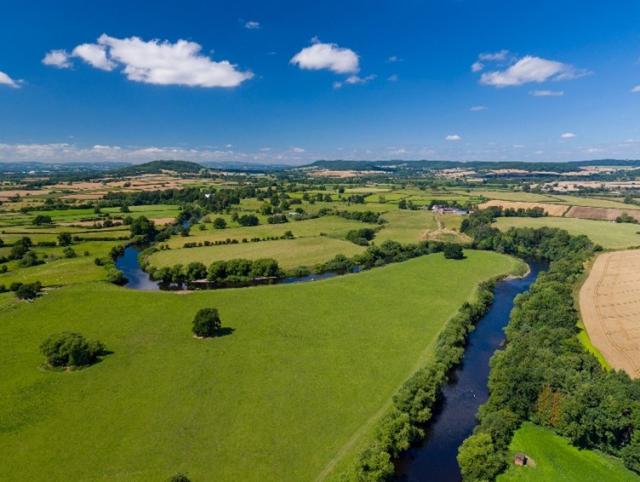
However, water quality throughout England is under pressure:
- Only 14% of assessed lakes are at good ecological status and 14% of rivers achieve good ecological status.
- No river achieves a good status for chemical contamination. [1]
This pollution stems from a range of sources, including waste and storm water overflows, run-off from towns, cities and transport, changing climate impacts, and agriculture.
How Does Agriculture Impact Water Quality?
Agriculture can impact water quality in a number of ways, often as a result of agricultural inputs such as fertilisers and pesticides getting into waterbodies. The sources of pollution can be considered in two ways:
- Point source - a direct pollution source such as a wastewater pipe runoff, or a poorly maintained slurry store; or
- Diffuse - smaller amounts of pollution that are often individually minor, but collectively can result in significant environmental damage, such as nitrogen runoff and seepage at multiple points across a catchment.
| Key Contaminant | Description | How Does it Enter Water Bodies | Risk to Water Quality |
| Nitrogen | Nitrogen is a major nutrient often applied in synthetic or organic fertiliser; or found in livestock manure. | Nitrogen is water soluble so can enter water bodies via overland flow or leaching through the soil. | Excessive nutrient enrichment causes the deoxygenation of water through eutrophication which is damaging to the surface water ecology. Eutrophication can lead to blue-green algae outbreaks which can be deadly to dogs and livestock and cause illness in humans. Excess nitrogen can lead to drinking water issues. |
| Phosphorous | Phosphorous is a major nutrient often applied in synthetic or organic fertiliser; or found in livestock manure. | Phosphorus binds to soil particles and can reach water bodies via overland flow and land drains. | |
| Faecal Indicator Organisms (FIOs) | FIOs, such as E. Coli are pathogens which are commonly found in the intestines of animals and humans. | FIOs from animals can enter water bodies via direct contamination or via run-off from slurry and manure. | Excess FIOs in water bodies pose a risk to human health and can make water bodies unsuitable for recreational use or abstraction. |
| Sediment | Sediment is the mineral and organic material from soil and waste that is eroded. | Sediment can enter water through surface run off or erosion from yards and fields and through land drains. | Excess sediment in water bodies can impact on the ecology of a water body. It can also pose a risk to human health, and impact amenity values in water bodies such as clarity. |
| Other Chemicals | Other chemicals used in agriculture, such as pesticides, herbicides and fungicides to control pests and weeds, or veterinary medicines and sheep-dip. | Excess or inappropriate use of agrichemicals around water bodies can result in run off to water bodies. Chemicals can also reach water from chemical handling or storage areas. | Agrichemicals can pollute rivers and prove toxic to aquatic life or pose a risk to human or animal health. |
How to Reduce Impact on Water Bodies:
In managing and reducing impacts on water quality from agriculture it is important to understand:
- Your natural environment, the relationship between your farm and local water bodies, and how water flows through your farm to understand where pollution risk areas might be.
- The activities on your farm and how these might be contributing to pollution.
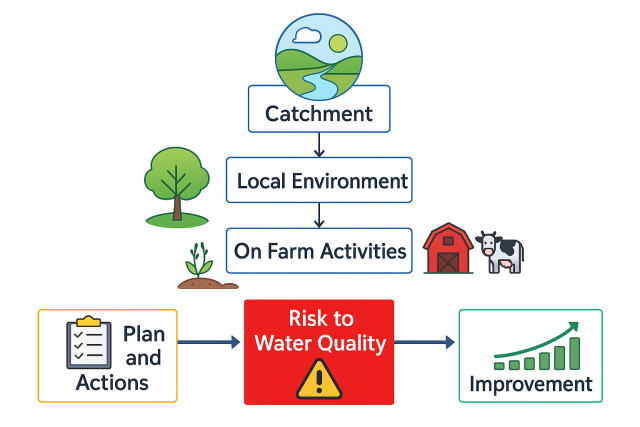
Catchment: Know your catchment, key issues and priorities to help understand risks to water quality and where to put your focus.
Local Environment: Know your local environment and map your farm; soils, topography, water flow paths, locations of water bodies, woodlands and hedgerows. This will help you better understand where water flows from you farm and where contaminants may be at risk of entering water.
On Farm Activities: Map activities on farm over your local environment to visualise your risks. Map your infrastructure and the different farming activities you are doing. This will help you to illustrate the possible impacts of your current farming activities and where contaminants from farming may be at risk of entering water.
Plan and Actions: Develop, plan and review actions to address risks to water quality, to help you reduce and monitor contaminant losses to water bodies. Remember to keep actions achievable and practical.
Use the ALERT free mapping tool created by the Environment Agency on behalf of Catchment Sensitive Farming to help farmers and our local advisers analyse the landscape and reduce pollution from agriculture- Tools | Farming Advice Service
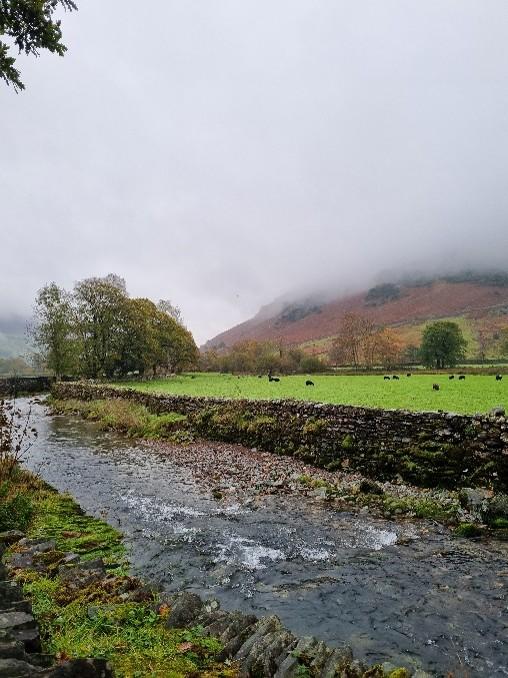
Where to Get Help:
- FAS / CSF: FAS, CSF and a range of partners and stakeholders can help provide advice on improving water quality, meeting compliance requirements and accessing available grant and scheme funding. CSF advisers provide farmers with free, confidential advice and guidance, including one to one farm visits.
- Other farmers: Many catchments around the country have catchment or discussion groups of farmers working together to improve water quality. Engaging with these groups or talking to neighbours will improve your understanding of local issues, how your farm might be contributing to quality issues, and effective actions to take to reduce pollution.
- Grants and Schemes: There is a range of funding support available that has a specific focus on actions to reduce impacts on water quality. Look at the Funding For Farmers page on GOV.UK and talk to advisors for assistance on what grants and schemes are open and that may be relevant.
- Other Advisors: Your farm consultant or advisors can help you understand where pollution is coming from and what action you can take.
Key Regulations:
There are a number of legal requirements that need to be followed in relation to water quality, including:
- Farming Rules for Water
- Nitrate Vulnerable Zones
- Silage, Slurry and Agricultural Fuel Oil Regulations
- The Health and Safety Executive Code of Practice for using Plant Protection Products
- The Environmental Permitting (England and Wales) Regulations
The Environment Agency Handbook- Harvesting Success: Pollution-Prevention Rules for Farmers, provides a guide to the regulations and rules to reduce water pollution risks on farm. Remember to always manage your specific impacts from your farm on water quality first and foremost.
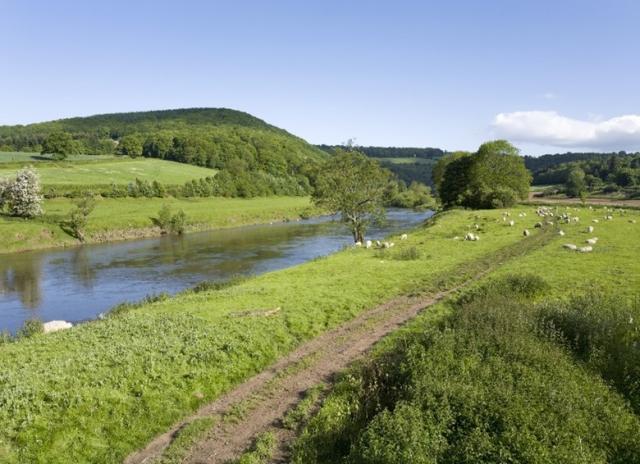
For more information on regulations and their specific requirements, view the Rules for farmers and land managers page on GOV.UK.
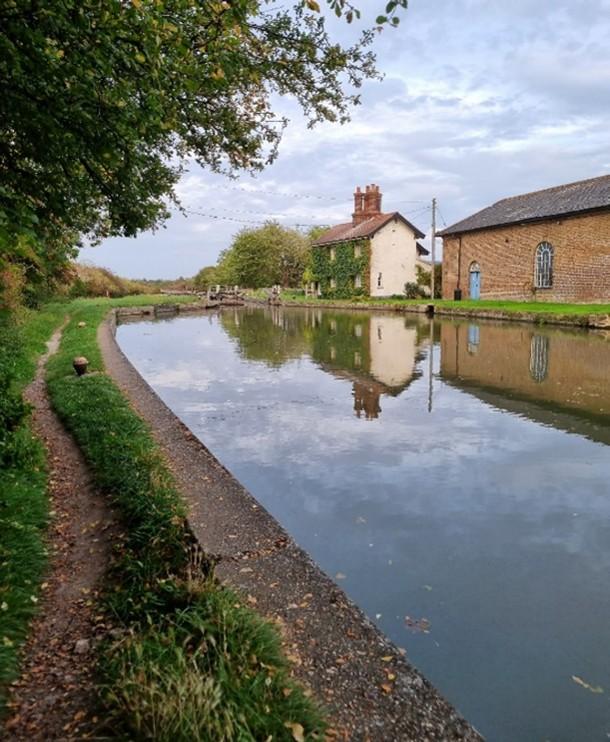
Other Benefits:
Managing impacts on water quality can result in a range of other benefits for the environment and your farm business including:
- Making your business more efficient by maximising use of resources and reducing costs.
- Improved resilience to climate change, floods and droughts.
- Reduced loss of topsoil to erosion and improved soil health which is better for production.
- Improved biodiversity across the farm.
- Reduced risk to drinking water sources.
- Greater recreational opportunities.
- Less risk of noncompliance and financial penalties associated with relevant regulations.
Common Water Quality Problems and What to Do:
Table 3 contains some common activities on farm that can often contribute to water quality issues, and how contaminant losses may be addressed.
| Activity | Description | Potential Ways to Address Issues |
| Livestock Poaching | Livestock congregation around water troughs, gateways and in and around water bodies, can increase soil erosion or compaction, and the chance of runoff of manure and sediment. This can lead to increased levels of sediment, FIOs and nutrients in water. |
|
Slurry- Manure Storage
| Not having enough storage for your slurry or not having appropriate protection from weather can increase the amount of slurry you are required to store and the frequency of application to land and pose a risk to water bodies. |
|
| Soil Erosion | A lack of protection of soils, or overgrazing, can lead to erosion issues such as gully, sheet, or wind erosion. This can increase sediment loads in water bodies and provide runoff pathways for other contaminants. |
|
| Fertiliser Application | Excess fertiliser application or applying fertiliser too close to water bodies can lead to leaching and runoff of fertiliser to water. |
|
| Pesticide handling and application | Inappropriate pesticide storage, handling and application can lead to point source and diffuse pollution of surface and ground water. |
|
Hugh Loughnan: Farming Advice Service
Charles Chantler & Thomas Blatherwick: Catchment Sensitive Farming